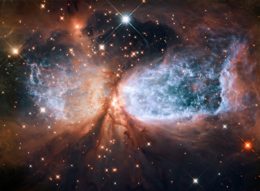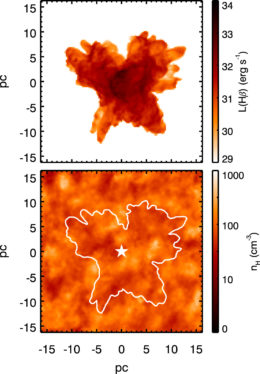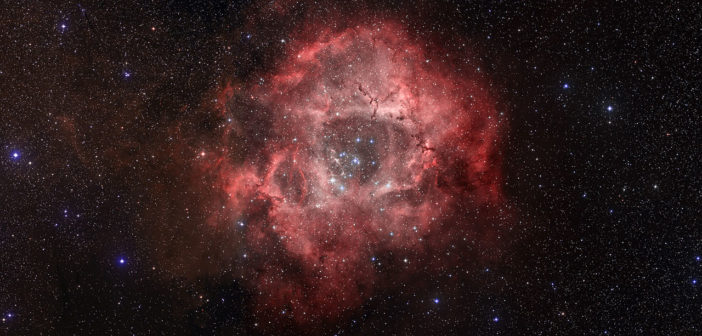Researchers have modeled the turbulent gas of the interstellar medium in a new way, with important implications for how we interpret observations of distant galaxies.
Probing the Early Universe

The nebulae surrounding young stars, like the S106 star-forming region pictured here, frequently show intricate and irregular structure. [NASA & ESA]
In a recent study, a team led by Yifei Jin (金刈非; Australian National University and ARC Centre of Excellence for All Sky Astrophysics in 3 Dimensions) used photoionization models — with a turbulent twist — to simulate the intricate emission nebulae that surround young, massive stars in galaxies near and far.

Top: The modeled H-beta emission from the nebula. Bottom: The density of the interstellar gas with the outline of the nebula traced on top. [Jin et al. 2022]
Forming Fractal Gas
Jin and collaborators used state-of-the-art models to simulate realistic emission nebulae from turbulent interstellar gas. The team placed a synthetic O star a million times more luminous than the Sun at the center of a cube 140 light-years on each side. They filled the cube with gas with an average density of 100 particles per cubic centimeter — a typical value for nebulae in the Milky Way — and the same chemical composition as the Sun.
The main advance in this work is the use of a fractal density pattern for the simulated interstellar gas. Unlike previous models, which assumed that the gas had the same density throughout, the team’s model incorporates density variations on large and small scales, resulting in a clumpy interstellar medium similar to what is seen in observations. As high-energy photons from the synthetic O star ionize the gas, they create an emission nebula with a complex and irregular shape.
Volume versus Boundary
To determine the properties of their modeled nebula, Jin and collaborators tracked the strength of the emission lines and categorized each emission line as either a volume species or a boundary species, depending on where in the nebula the line was produced. The volume species — H-alpha, H-beta, and [O III] — are produced mainly in the body of the nebula, while the boundary species — [O I], [S II], and [N II] — are produced along the outer edge.

Comparison of the fluxes of several emission lines and emission-line ratios between the realistic nebula case and the spherical nebula case. A value of zero indicates no change in flux or the flux ratio. Click to enlarge. [Jin et al. 2022]
This study by Jin and collaborators demonstrates that modeling turbulent interstellar gas in a realistic way can have a huge impact on the resultant emission lines — which in turn has implications for how we interpret emission lines from distant galaxies. The team predicts that using fractal geometry for models of interstellar gas will be key to interpreting observations of galaxies early in the universe, when interstellar gas was likely highly turbulent.
Citation
“Theoretically Modeling Photoionized Regions with Fractal Geometry in Three Dimensions,” Yifei Jin et al 2022 ApJL 934 L8. doi:10.3847/2041-8213/ac80f3

